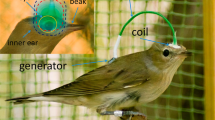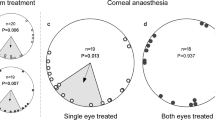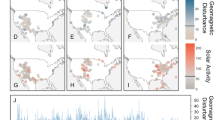Abstract
Lateralization of brain functions, once believed to be a human characteristic, has now been found to be widespread among vertebrates1,2,3. In birds, asymmetries of visual functions are well studied, with each hemisphere being specialized for different tasks4,5,6,7,8. Here we report lateralized functions of the birds' visual system associated with magnetoperception, resulting in an extreme asymmetry of sensing the direction of the magnetic field. We found that captive migrants tested in cages with the magnetic field as the only available orientation cue were well oriented in their appropriate migratory direction when using their right eye only, but failed to show a significant directional preference when using their left eye. This implies that magnetoreception for compass orientation, assumed to take place in the eyes alongside the visual processes9,10,11, is strongly lateralized, with a marked dominance of the right eye/left brain hemisphere.
This is a preview of subscription content, access via your institution
Access options
Subscribe to this journal
Receive 51 print issues and online access
$199.00 per year
only $3.90 per issue
Buy this article
- Purchase on Springer Link
- Instant access to full article PDF
Prices may be subject to local taxes which are calculated during checkout


Similar content being viewed by others
References
Vallortigara, G. Comparative neuropsychology of the dual brain: a stroll through animals' left and right perceptual worlds. Brain Lang. 73, 189–219 (2000)
Rogers, L. & Andrew, R. J. (eds) Comparative Vertebrate Lateralization (Cambridge Univ. Press, Cambridge, 2002)
Hunt, G. R., Corballis, M. C. & Gray, R. D. Laterality in tool manufacture by crows. Nature 414, 707 (2001)
Clayton, N. Lateralization and unilateral transfer of spatial memory in marsh tits. J. Comp. Physiol. A 171, 799–806 (1993)
Rogers, L. Behavioral, structural and neurochemical asymmetries in the avian brain: a model system for studying visual development and processing. Neurosci. Biobehav. Rev. 20, 487–503 (1996)
Güntürkün, O. Avian visual lateralization: a review. NeuroReport 8, 3–11 (1997)
Vallortigara, G., Regolin, L., Bortolomiol, G. & Tommasi, L. Lateral asymmetries due to preferences in eye use during visual discrimination learning in chicks. Behav. Brain Res. 74, 135–143 (1996)
Tommasi, L. & Vallortigara, G. Encoding of geometric and landmark information in the left and right hemispheres of the avian brain. Behav. Neurosci. 115, 602–613 (2001)
Ritz, T., Adem, S. & Schulten, K. A model for vision-based magnetoreception in birds. Biophys. J. 78, 707–718 (2000)
Wiltschko, W., Munro, U., Ford, H. & Wiltschko, R. Red light disrupts magnetic orientation of migratory birds. Nature 364, 525–527 (1993)
Wiltschko, W. & Wiltschko, R. Light-dependent magnetoreception in birds: the behaviour of European robins, Erithacus rubecula, under monochromatic light of various wavelengths and intensities. J. Exp. Biol. 204, 3295–3302 (2001)
Prior, H. & Güntürkün, O. Parallel working memory for spatial location and food-related object cues in foraging pigeons: binocular and lateralised monocular performance. Learn. Memory 8, 44–51 (2001)
Ulrich, C. I. et al. Left-hemisperic superiority for visuospatial orientation in homing pigeons. Behav. Brain Res. 104, 169–178 (1999)
Prior, H., Wiltschko, R., Stapput, K., Güntürkün, O. & Wiltschko, W. Orientation and Navigation—Birds, Humans and other Animals 25-1–25-8 (Royal Institute of Navigation, Oxford, 2001)
Wiltschko, W., Gesson, M. & Wiltschko, R. Magnetic compass orientation of European Robins under 565 nm green light. Naturwissenschaften 88, 387–390 (2001)
Wiltschko, W. & Wiltschko, R. Magnetic compass of European Robins. Science 176, 42–64 (1972)
Wiltschko, R. & Wiltschko, W. Magnetic Orientation in Animals (Springer, Berlin, 1995)
Semm, P., Nohr, D., Demaine, C. & Wiltschko, W. Neural basis of the magnetic compass: interaction of visual, magnetic and vestibular inputs in the pigeon's brain. J. Comp. Physiol. A 155, 283–288 (1984)
Semm, P. & Demaine, C. Neurophysiological properties of magnetic cells in the pigeon's visual system. J. Comp. Physiol. A 159, 619–625 (1986)
Beason, R. C. & Semm, P. Magnetic responses of the trigeminal nerve system of the Bobolink (Dolichonyx oryzivorus). Neurosci. Lett. 80, 229–234 (1987)
Hellmann, B. & Güntürkün, O. Structural organization of parallel information processing within the tectofugal visual system of the pigeon. J. Comp. Neurol. 429, 94–112 (2001)
Diekamp, B., Hellmann, B., Troje, N. F., Wang, S. R. & Güntürkün, O. Electrophysiological and anatomical evidence for a direct projection from the nucleus of the basal optic root to the nucleus rotundus in pigeons. Neurosci. Lett. 305, 103–106 (2001)
Mai, J. K. & Semm, P. Pattern of brain glucose utilization following magnetic stimulation. J. Hirnforsch. 31, 331–336 (1990)
Güntürkün, O. & Hahmann, U. Functional subdivisions of the ascending visual pathways in the pigeon. Behav. Brain Res. 98, 193–201 (1999)
Batschelet, E. Circular Statistics in Biology (Academic, London, 1981)
Acknowledgements
This work was supported by grants from the Deutsche Forschungsgemeinschaft. We thank K. Dutine, F. Eich, F. Schmidt and A. Wittekindt for their help with conducting the experiments.
Author information
Authors and Affiliations
Corresponding author
Ethics declarations
Competing interests
The authors declare that they have no competing financial interests.
Rights and permissions
About this article
Cite this article
Wiltschko, W., Traudt, J., Güntürkün, O. et al. Lateralization of magnetic compass orientation in a migratory bird. Nature 419, 467–470 (2002). https://doi.org/10.1038/nature00958
Received:
Accepted:
Issue Date:
DOI: https://doi.org/10.1038/nature00958
This article is cited by
-
Long-distance navigation and magnetoreception in migratory animals
Nature (2018)
-
Spontaneous magnetic alignment behaviour in free-living lizards
The Science of Nature (2017)
-
Radical-pair-based magnetoreception in birds: radio-frequency experiments and the role of cryptochrome
Journal of Comparative Physiology A (2017)
-
Quantum biology: explore quantum dynamics in biological systems
Science China Information Sciences (2016)
-
Upwash exploitation and downwash avoidance by flap phasing in ibis formation flight
Nature (2014)
Comments
By submitting a comment you agree to abide by our Terms and Community Guidelines. If you find something abusive or that does not comply with our terms or guidelines please flag it as inappropriate.



